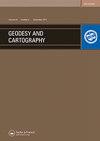测试 MGEX(GNSS(GPS+GLONASS+GALILEO+北斗+QZSS))的贡献、准确性和性能在研究区域的定位
IF 2.1
Q3 REMOTE SENSING
引用次数: 0
摘要
欧洲委员会(EC)最初于 1999 年提出了建立欧洲伽利略卫星导航系统的设想。该系统计划分四个阶段开发,涉及公共部门和商业部门的投资。伽利略系统旨在供公众和政府使用;该系统由民政部门管理和运行。伽利略系统将包括一个由 30 颗卫星组成的星座、若干分布在全球各地的地面站以及一个地面控制和监测系统--所有这些都与全球定位系统的结构、格式和布局十分相似。本文件讨论了在项目现场进行的一项实验,该实验采用静态方法整合 GPS、GLONASS、GALILEO、北斗和 QZSS 信号。这项研究分析了纯 GPS 和 GPS/GLONASS/GALILEO/Beidou/QZSS 可能达到的精度。这些结果表明,就测量目的而言,将 GPS 系统与 GALILEO、GLONASS 北斗和 QZSS 结合使用更为可取。在研究区域进行精度为 0-120 毫米的全球定位系统/格洛纳斯/伽利略/北斗/ QZSS 静态测量,似乎可以在三天内完成。本文章由计算机程序翻译,如有差异,请以英文原文为准。
TESTING THE CONTRIBUTION, ACCURACY AND PERFORMANCE OF MGEX (GNSS (GPS+GLONASS+GALILEO+BEIDOU+QZSS)) POSITIONING IN THE STUDY REGION
The European Commission (EC) originally proposed ideas for a European Galileo satellite navigation system in 1999. A four-phase development is planned, involving investment from both the public and commercial sectors. Galileo is intended for both public and government use; the system is administered and operated by civil administration. Galileo will consist of a constellation of 30 satellites, a number of globally situated ground stations, and a ground control and monitoring system – all of which are quite similar to the structure, format, and layout of GPS. This document discusses an experiment at the project site that used the static approach to integrate GPS, GLONASS, GALILEO, Beidou, and QZSS signals. This research analyses the possible precision of GPS-only and GPS/GLONASS/GALILEO/Beidou/QZSS. These results suggest that combining a GPS system with GALILEO, GLONASS Beidou, and QZSS is preferable for surveying purposes. Integrating GPS/GLONASS/GALILEO/Beidou/QZSS static measurements in the study region with 0–120 millimetre accuracy looks to be possible in three days.
求助全文
通过发布文献求助,成功后即可免费获取论文全文。
去求助
来源期刊

Geodesy and Cartography
REMOTE SENSING-
CiteScore
1.50
自引率
0.00%
发文量
0
审稿时长
15 weeks
期刊介绍:
THE JOURNAL IS DESIGNED FOR PUBLISHING PAPERS CONCERNING THE FOLLOWING FIELDS OF RESEARCH: •study, establishment and improvement of the geodesy and mapping technologies, •establishing and improving the geodetic networks, •theoretical and practical principles of developing standards for geodetic measurements, •mathematical treatment of the geodetic and photogrammetric measurements, •controlling and application of the permanent GPS stations, •study and measurements of Earth’s figure and parameters of the gravity field, •study and development the geoid models,
 求助内容:
求助内容: 应助结果提醒方式:
应助结果提醒方式:


